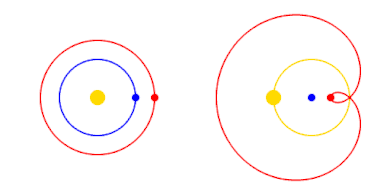Revolusi Copernicus: Perbedaan antara revisi
Tampilan
Konten dihapus Konten ditambahkan
←Membuat halaman berisi 'thumb|upright=1.75|Gerak [[Matahari (kuning), Bumi (biru), dan Mars (merah). Di bagian kiri, gerak heliosentris menurut Copernicus. Di bagian kanan, gerak geosentris tradisional.]] '''Revolusi Copernicus''' adalah perubahan paradigma dari anggapan bahwa Bumi merupakan pusat alam semesta menjadi model heliosentris yang menyatakan bahwa Matahari adalah pusat Tata...' Tag: pranala ke halaman disambiguasi |
(Tidak ada perbedaan)
|
Revisi per 21 Desember 2021 04.00

Revolusi Copernicus adalah perubahan paradigma dari anggapan bahwa Bumi merupakan pusat alam semesta menjadi model heliosentris yang menyatakan bahwa Matahari adalah pusat Tata Surya. Pada 1593, Revolusi Copernicus dimulai.[1] Revolusi tersebut terdiri dari dua fase; yang pertama lebih kepada matematika dan fase kedua bermula pada 1610 dengan publikasi sebuah pamflet oleh Galileo.[2] Bermula dengan penerbitan 'De revolutionibus orbium coelestium karya Nicolaus Copernicus, kontribusi-kontribusi terhadap “revolusi” tersebut berlanjut sampai akhirnya berakhir dengan karya Isaac Newton pada seabad berikutnya.
Catatan
Referensi
- ^ author., Crowe, Michael J. (2013). Theories of the World from Antiquity to the Copernican Revolution. Dover Publications. ISBN 978-0-486-31559-1. OCLC 968104749.
- ^ Gillies, Donald (2019-04-10), Why did the Copernican revolution take place in Europe rather than China?, diakses tanggal 2019-12-03
Karya kutipan
- Bala, Arun (2006). The Dialogue of Civilizations in the Birth of Modern Science. New York: Palgrave Macmillan. ISBN 978-0-230-60121-5. OCLC 191662056.
- Drake, Stillman (1978). Galileo At Work. Chicago: University of Chicago Press. ISBN 0-226-16226-5.
- Drake, Stillman (1990). Galileo: Pioneer Scientist. Toronto: The University of Toronto Press. ISBN 0-8020-2725-3.
- Galilei, Galileo (1989). Sidereus Nuncius. Albert Van Helden (trans.). Chicago, Illinois: University of Chicago Press. ISBN 9780226279039.
- Gillies, Donald. (2019). Why did the Copernican revolution take place in Europe rather than China?. https://www.researchgate.net/publication/332320835_Why_did_the_Copernican_revolution_take_place_in_Europe_rather_than_China
- Gingerich, Owen. “From Copernicus to Kepler: Heliocentrism as Model and as Reality.” Proceedings of the American Philosophical Society 117, no. 6 (December 31, 1973): 513–22.
- Huff, Toby E. (2017). The Rise of Early Modern Science. Cambridge: Cambridge University Press. ISBN 9781316417805.
- Huff, Toby E. (Autumn–Winter 2002). "The Rise of Early Modern Science: A Reply to George Sabila". Bulletin of the Royal Institute of Inter-Faith Studies (BRIIFS). 4, 2.
- Kuhn, Thomas S. (1957). The Copernican Revolution: Planetary Astronomy in the Development of Western Thought. Cambridge, Massachusetts: Harvard University Press. ISBN 0-674-17103-9.
- Kuhn, Thomas S. (1970). The Structure of Scientific Revolutions. Chicago: Chicago University Press. ISBN 0226458032.
- Kunitzch, Paul. “The Arabic Translations of Ptolemy's Almagest.” Qatar Digital Library, July 31, 2018. https://www.qdl.qa/en/arabic-translations-ptolemys-almagest.
- Koyré, Alexandre (2008). From the Closed World to the Infinite Universe. Charleston, S.C.: Forgotten Books. ISBN 9781606201435.
- Lawson, Russell M. Science in the Ancient World: An Encyclopedia. Santa Barbara, CA: ABC-CLIO, 2004.
- Lin, Justin Y. (1995). The Needham Puzzle: Why the Industrial Revolution Did Not Originate in China. Economic Development and Cultural Change, 43(2), 269-292. Retrieved from https://www.jstor.org/stable/1154499.
- Metzger, Hélène (1932). Histoire des sciences. Revue Philosophique De La France Et De L'Étranger, 114, 143-155. Retrieved from https://www.jstor.org/stable/41086443.
- Osler, Margaret (2010). Reconfiguring the World. Baltimore, Maryland: The Johns Hopkins University Press. hlm. 184. ISBN 978-0-8018-9656-9.
- Redd, Nola (May 2012). "Johannes Kepler Biography". Tech Media Network. Diakses tanggal October 23, 2013.
- Rushkin, Ilia. “Optimizing the Ptolemaic Model of Planetary and Solar Motion.” History and Philosophy of Physics 1 (February 6, 2015): 1–13.
- Saliba, George (1979). "The First Non-Ptolemaic Astronomy at the Maraghah School". Isis. 70 (4). ISSN 0021-1753.
- Sabila, George (Autumn 1999). "Seeking the Origins of Modern Science?". Bulletin of the Royal Institute for Inter-Faith Studies (BRIIFS). 1, 2.
- Sabila, George (Autumn–Winter 2002). "Flying Goats and Other Obsessions: A Response to Toby Huff's "Reply"". Bulletin of the Royal Institute for Inter-Faith Studies (BRIIFS). 4, 2.
- Singer, Charles (2007). A Short History of Science to the Nineteenth Century. Clarendon Press.
- Swetz, Frank J. “Mathematical Treasure: Ptolemy's Almagest.” Mathematical Treasure: Ptolemy's Almagest | Mathematical Association of America, August 2013. https://www.maa.org/press/periodicals/convergence/mathematical-treasure-ptolemy-s-almagest.
- Thoren, Victor E. (1989). Tycho Brahe. In Taton and Wilson (1989, pp. 3–21). ISBN 0-521-35158-8.
Pranala luar
 Definisi kamus Copernican Revolution di Wikikamus
Definisi kamus Copernican Revolution di Wikikamus Media terkait Copernican Revolution di Wikimedia Commons
Media terkait Copernican Revolution di Wikimedia Commons
